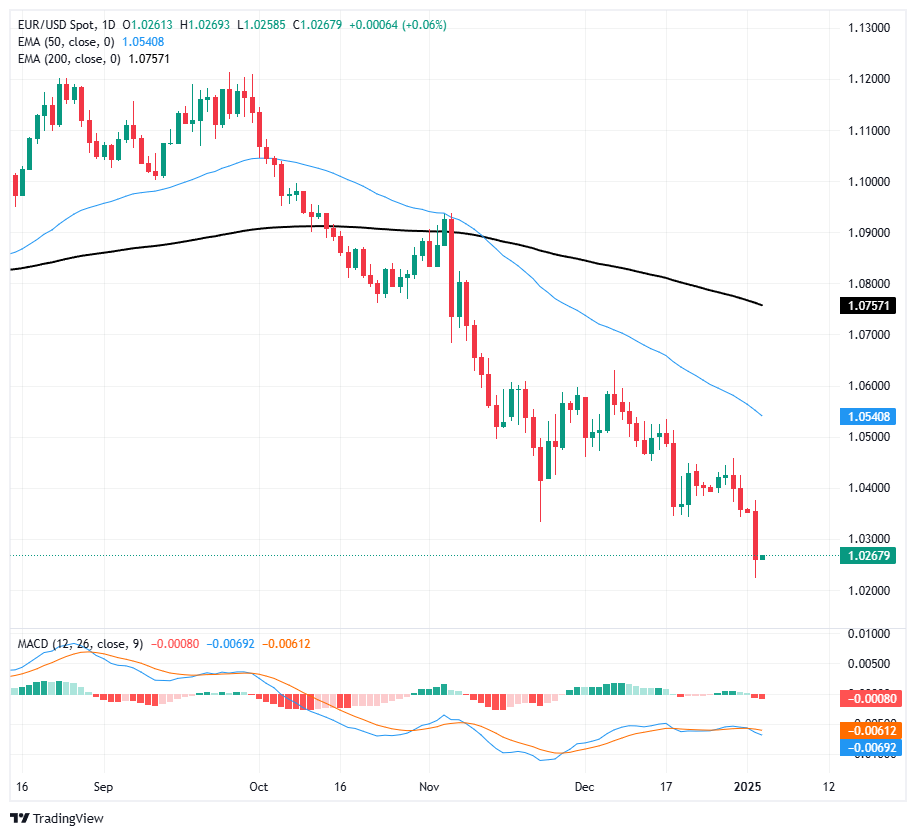- EUR/USD fell 0.8% on the first trading day of the new year.
- Bearish sentiment looms over the weakened Euro.
- The rate differential is expected to widen further, with analysts expecting parity in 2025.
EUR/USD took another step down to begin the 2025 trading season, falling eight tenths of a percent and touching the 1.0250 level for the first time since November 2022, a nearly 26-month low. Europe’s Manufacturing Purchasing Managers’ Index (PMI) data missed expectations on Thursday, only adding to Euro traders’ concerns following a dovish appearance from European Central Bank (ECB) policymaker Yannis Stournaras, later in the day.
According to ECB Governing Council member Yannis Stournaras, the ECB is on track to reduce interest rates steadily until 2025. The ECB is expected to be around 2% by the end of this year, according to Stournaras of the ECB. With the Federal Reserve (Fed) on track to reduce interest rates at a much slower pace than previously expected in 2025, the Euro interest rate differential is expected to widen significantly over the remainder of the year, which will maintain bearish pressure on EUR/USD in the long term. This is in line with the expectations of some analysts who predict that the Euro will reach parity with the Dollar at some point this year.
The results of the pan-European PMI survey fell slightly in December, falling to 45.1 versus the expectation of holding at 45.2. Although the data itself had relatively little impact, it helped highlight the growing likelihood that the European Central Bank (ECB) would accelerate rate cuts to boost the European economy, even as oil prices hit their own two-year highs. , further complicating the European economic prospects.
The only significant data on Friday’s economic calendar are the US ISM Manufacturing PMI survey results, which are expected to hold steady at a contractionary 48.4 for December.
EUR/USD Price Forecast
EUR/USD has fallen 8.82% top-to-bottom since September’s high bids just above the 1.1200 level, although short sellers have not yet been able to breach the 1.0200 level. A bearish divergence on the Moving Average Convergence/Divergence (MACD) indicator is becoming difficult to ignore, implying more technical losses on the horizon.
Fiber bids are being pushed further lower by a descending 50-day EMA falling to 1.0550. If bidders stage a recovery beyond this point, the 200 day EMA will be waiting just above at 1.0760.
EUR/USD Daily Chart
Euro FAQs
The Euro is the currency of the 19 countries of the European Union that belong to the eurozone. It is the second most traded currency in the world, behind the US dollar. In 2022, it accounted for 31% of all foreign exchange transactions, with an average daily turnover of more than $2.2 trillion per day. EUR/USD is the most traded currency pair in the world, accounting for an estimated 30% of all transactions, followed by EUR/JPY (4%), EUR/GBP (3%) and EUR/AUD (2 %).
The European Central Bank (ECB), headquartered in Frankfurt, Germany, is the reserve bank of the eurozone. The ECB sets interest rates and manages monetary policy. The ECB’s primary mandate is to maintain price stability, which means controlling inflation or stimulating growth. Its main tool is the increase or decrease in interest rates. Relatively high interest rates (or the expectation of higher rates) tend to benefit the euro and vice versa. The Governing Council of the ECB makes decisions on monetary policy at meetings held eight times a year. Decisions are made by the directors of the Eurozone’s national banks and six permanent members, including ECB President Christine Lagarde.
Eurozone inflation data, measured by the Harmonized Index of Consumer Prices (HICP), are an important econometric indicator for the euro. If inflation rises more than expected, especially if it exceeds the ECB’s 2% target, it forces the ECB to raise interest rates to bring it back under control. Relatively high interest rates compared to their counterparts tend to benefit the euro, making the region more attractive as a place for global investors to park their money.
The published data measures the health of the economy and may have an impact on the euro. Indicators such as GDP, manufacturing and services PMIs, employment and consumer confidence surveys can influence the direction of the single currency. A strong economy is good for the Euro. Not only does it attract more foreign investment, but it may encourage the ECB to raise interest rates, which will directly strengthen the euro. Otherwise, if economic data is weak, the Euro is likely to fall. Economic data for the four largest eurozone economies (Germany, France, Italy and Spain) are especially significant, as they represent 75% of the eurozone economy.
Another important data that is published about the Euro is the trade balance. This indicator measures the difference between what a country earns from its exports and what it spends on imports during a given period. If a country produces highly in-demand export products, its currency will gain value simply from the additional demand created by foreign buyers seeking to purchase those goods. Therefore, a positive net trade balance strengthens a currency and vice versa in the case of a negative balance.
Source: Fx Street
I am Joshua Winder, a senior-level journalist and editor at World Stock Market. I specialize in covering news related to the stock market and economic trends. With more than 8 years of experience in this field, I have become an expert in financial reporting.







